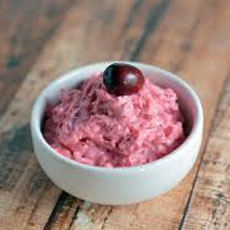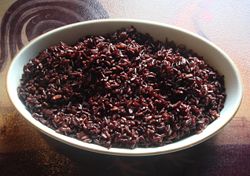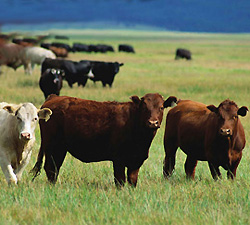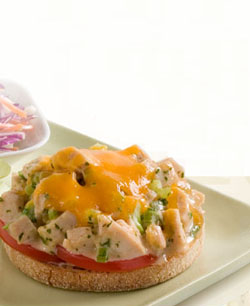


[1] Make this delicious “Fallwich” with your Thanksgiving leftovers (photo courtesy New England Soup Factory). [2] Cranberry mayonnaise (photo courtesy Savory Experiments), which uses a 1:1 proportion of mayo and cranberry. [3] The New England Soup Factory Cookbook, which contains this recipe. |
|
Here’s how to combine all of those Thanksgiving leftovers into a delicious fall sandwich or “Fallwich,” created by Marjorie Druker of the New England Soup Factory in Newton, Massachussetts. The recipe is a winner in this year’s The Ultimate Cranberry Recipe Contest for foodservice professionals, sponsored by Ocean Spray; and is published in the New England Soup Factory Cookbook.
It’s a delicious sandwich, even if you have to start from scratch, without leftovers.
RECIPE: FALLWICH, A THANKSGIVING LEFTOVERS SANDWICH
Ingredients For 4 Sandwiches
For The Cranberry Mayonnaise
3/4 cup mayonnaise
1/4 cup whole berry cranberry sauce or relish (or more to taste)
Baguette cut into four 6-8 inch pieces, or 4 similar rolls
Leftover sweet potatoes, or 2 large sweet potatoes, scrubbed but not peeled
2 tablespoons olive oil
Kosher salt and freshly ground black pepper, to taste
4 individual size (8 inches long each) baguettes
8 tablespoons cranberry mayonnaise)
1-1/2 cups baby spinach leaves, washed
1 pound leftover turkey or purchase roasted turkey breast, sliced
Cranberry sauce or 6 tablespoons honey-roasted cashews
Preparation
1. MAKE the mayonnaise: Whisk together the mayonnaise and cranberry sauce in a small mixing bowl, until well incorporated. If you need to make sweet potatoes:
2. PREHEAT the oven to 400°F. Cut the sweet potatoes into 3-inch chunks. Place in a roasting pan and sprinkle with the olive oil, salt, and pepper. Bake for 30 to 35 minutes, stirring once or twice. Remove from the oven and cool to room temperature.
3. SPREAD the both cut sides of each sandwich with the cranberry mayonnaise. Place the spinach leaves on the bottom slice of each baguette bottom. Layer the turkey breast, then the mashed or roasted sweet potatoes.
4. SPRINKLE with the honey-roasted cashews and season with salt and pepper. Place the top slice of bread on each sandwich.
|






